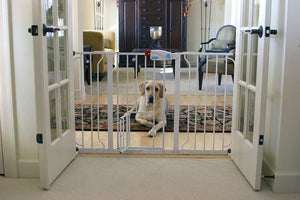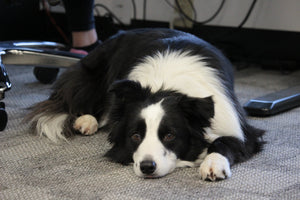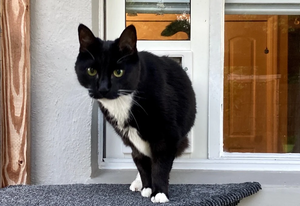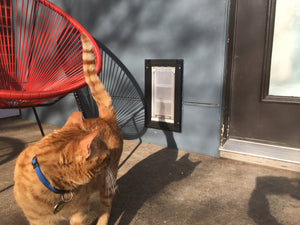Bringing a New Dog Home
Congratulations! Welcome to your first day with your new best friend. When you bring home a bumbling puppy, an older adoptee from an animal shelter, or a grateful rescue dog, your life is about to be changed for the better.
Sure, there will be chewed shoes, late-night barking episodes, and early-morning howling streaks. And yes, house rules will be broken and there will be accidents on the carpet. But there will also be a welcoming wagging tail to greet you when you get home a furry companion to rest in your lap or curl at your feet, and there will be endless, unconditional love, from day one of you bringing your pooch home and onwards.

When preparing for a puppy, or any new addition to your family, it's important to know how to get a dog that suits your lifestyle. If you're being proactive and are still thinking about what pet to choose, consider finding out what dog breeds best match your personality?
Note that future dog behavior can be hard to predict in puppies. If you adopt an older, shelter dog, you will have a higher chance of getting a dog with a temperament that matches your lifestyle.
A few chewed shoes in return for endless love and companionship from bringing a puppy home? Sounds like a fair trade to me! But bringing home your first dog is a massive life change, and it’s not without a few investments on your part. But facing a pet store alone can be a daunting task. Wee wee pads? Nylabones? Kongs? Chew toys, dog food, and water bowls? Dog beds, pillows, and stairs? Which of these do you really need? Have no fear, new pet owners. Here’s a quick guide to what to do when bringing a new dog home.
Bringing Home a Puppy:
#1 Plan Family Introductions
Slowly is the best way to introduce a dog to a new home. If you have other pets or little children, this is especially true. Everything should be as natural as possible, remember that your pet is entering a brand new environment and it is normal for them to be nervous.
DO NOT force any interactions between pets, because it can cause resentment amongst your pets because it can cause resentment amongst your new pup and the current resident dog. Instead, when your pets are ready to interact, be sure to encourage them in a positive way. Let them sniff, or graze, or act in any other ways that seem social as they get to know each other. After about two minutes or so, remove the pets from each other to avoid any aggressive body language from showing.
Body movements can also clue you in about how each pet is feeling. If one is baring its teeth, growling, or if their movement becomes rigid, these can be signs of aggression. If pets become hostile towards one another they should be removed from one another immediately and brought back together later for another try.
#2 Set Expectations Early
Interrupt any bad behaviors early to let them know that these are not acceptable behaviors. Show them that you make the rules, or they will take advantage of there being none. Jumping on visitors, bite when taking treats, and stealing food from the table should be seen as off-limits. If you want to know more about dog training, read about How to Train a Dog Not to Bite Strangers.
When you have multiple pets, feeding bowls, chews, toys, and even sleeping space can cause a rivalry between even the most docile pets. Clearly indicate what belongs to each pet, where each pet sleeps, and where they are allowed so that there are no fights over what belongs to whom. If you do not have time to train the dog yourself, then consider hiring a dog trainer or take your pup to dog training classes. Dog trainers are dog behaviorist experts and will be able to help.
#3 Develop a Routine
Like with many things in life, consistency is key. Establishing a clear routine for your pet early on can make it easier for them to learn acceptable behaviors. Change is difficult and inconsistency can be overstimulating for a new pet. Be sure that walks, outings, feedings, and playtime all happen during generally the same hours and that they are getting plenty of it to eliminate bad behavior. Taking a dog out for a walk at the same time every day will get a dog used to it, and they will be less likely to be energetic afterward.#4 Be Patient
Things will not always happen overnight. Having realistic expectations will help keep the introductory process in perspective. You can’t force your pet to like your home immediately, and you can’t force your older pet(s) to like your newer one right away. New puppy care is not unlike caring for a human puppy! Follow the tips, be consistent, and be patient and you will slowly see how your pet becomes adjusted to your home and will view it as a safe place.#5 Install a Dog Door
Installing a dog door is a great way to give your dog and you more freedom. Not only does it increase the quality of life for your pet but it also lifts the burden from you to let your pet in an out all the time. There are lots of different factors that go into installing the correct pet door such as size, the location of the door (sliding door, screen door, wall door), and functionality (Electronic, Locking, etc...). Introducing your pup to a pet door is also a helpful way to facilitate potty training and making sure you have the correct pet door is crucial. Take a look at these Pet Door Training Tips for more information on the benefits of pet doors.#6 Food and Water
Make sure that you have a designated area where your pet will have access to their food and water. While you may want to limit your pet’s access to food at certain times, it is important that the time and place is consistent. Feeding them at a specific time and place will help them get a routine and know where to expect their food to be. Dogs can get aggressive if this routine is disrupted.#7 Leashes
Retractable leashes are handy for trained dogs, but if you’re working on leash-training, you’ll need a standard (non-retractable) leash. The reason? On retractables, dogs learn that they’ll get to go farther and faster if they start pulling. On a standard leash, pulling gets them nowhere. Excellent for dogs just starting to be leash trained, they will try to leave your side but quickly learn that is not acceptable behavior. As they learn to walk with you on a standard leash you can then switch to a retractable as they gain your trust.#8 The Crate Debate
If you’re going to crate-train your dog, it’s better to do it from the get-go. Contrary to popular belief, crate-training doesn’t mean locking your pet up for hours on end; rather, it gives your place a den-like space to go and be comfortable when you need to secure your dog (when you have dog-shy guests or service professionals over at your house, getting your house cleaned or painted, etc.). Instead of panicking at the thought of being in an enclosed space, dogs feel safe and secure in their “den". It can also help establish a routine place to sleep, and limit accidents in your home.#9 Toys
Finally, remember that toys aren’t a luxury; they’re a necessity. Just like humans require stimulation. Imagine being pent up in a room with no iPhone, no computer, no TV, no books, nothing. You’d go crazy, right? Dogs are social creatures too and they need to occupy themselves just as much as you do. Puppies have natural chewing instincts, so be sure to stock up on some chewing toys or risk that puppy taking out its urge to chew on your furniture.#10 A Few Final Tips on Buying Pet Supplies for Your Puppy
Owning a dog is an investment and therefore it's important to look for products that will grow with your puppy. Remember, that it’s not a good idea to take your puppy into the pet store with you. Your puppy’s immune system isn’t fully developed yet, so he won’t be equipped to handle the germs that adult dogs carry.
As soon as your puppy is fully immunized, your new furry companion will be ready to go out and enjoy the world with you. Now that your new family member has arrived, what next? After adjusting to new surroundings, friends, and family, puppies will soon need to be transitioned into a housebreaking routine. Read on to learn about the best puppy tips for the first week and learn how to take care of a puppy's potty training!
House Training Tips
Consistency and patience are two key qualities necessary to successfully house-train a puppy. Each puppy is different, but adopting these general techniques is sure to assist in the housebreaking process. Larger dogs may adapt to their routine quickly, while smaller dogs generally take longer to be house trained. Puppies can generally hold their bladder one hour for every month of age. This means that a three-month-old puppy can hold its bladder for approximately three hours.Regular Routines
Puppies adapt best to a routine. It is best to have designated times for puppies to sleep, play, eat, and go out. Having a regular feeding schedule will help to establish consistency, as well as predetermined times to take your puppy outdoors. Puppies should go out promptly after eating, drinking, and any kind of exciting activity (such as playing).
Make sure to also initiate taking your puppy outside every night before bed, as well as every morning when you wake up. Taking your puppy out frequently will ensure minimal accidents. It is important to take your puppy outdoors at least every two hours, as well as any other time that you notice your puppy indicating they need to go out.
Training Time
Pick a spot outside where you want to train your puppy to go. Using a short phrase such as ‘go potty’ or ‘outside’ will help establish recognition between the phrase and action. This also reinforces consistency in the house training routine. Make sure to stand quietly and don’t do anything that may startle or distract your puppy. Additionally, playing or going for a walk before your puppy goes can be a major distraction. Focus on the training and your puppy will soon learn to focus as well.Remember Rewards
Always positively respond to your puppy after he or she goes outdoors. This can either be through praise or with a treat. The most important aspect of this step is to remember to respond with an immediate reward so that the reward is positively associated with the behavior. Puppies are easily distracted, and won’t associate a delayed reward with previous behavior.Watch Your Puppy
Close observation of your puppy can be another way to pro-actively accelerate the training process and prevent potential accidents. Often puppies will begin to show some sort of indication that they need to go out (whether it’s standing at the door, circling, sniffing the ground, or barking). With careful supervision, it becomes easy to pick up on these signs and actively address the need for your puppy to go outdoors.When you have to leave your puppy
Obviously, at times you will not be at home and therefore unable to watch your puppy. When this does occur, it is most effective to keep puppies in a small area, such as a pen or a crate. Puppies naturally don’t ‘go’ in the same area that they rest or sleep. Therefore, confining a puppy to a smaller area where they have a bed and enough room to comfortably stand and lie down will encourage puppies to wait until they are able to go outdoors.

When used correctly, crates can be very beneficial in training puppies and a puppy will often quickly adapt to viewing a crate as a type of den or sleeping area. If you prefer to not utilize a crate for house training, small pens or dog-proof baby gates can be used to block off areas such as the laundry room or family room. Most importantly, make sure as soon as you arrive home you promptly take your puppy outdoors, and follow the steps previously outlined to establish a routine.
Remember: young puppies cannot be expected to hold their bladder for more than a couple hours at a time (at most!) so if you are going to be away from home for a long period, consider arranging for a neighbor or pet sitter to come and take your puppy out.
Paper Training
Another option for puppies that will be indoors for longer periods of time is paper training. Paper training can be an effective way to teach puppies to go indoors while still preventing accidents. Using newspapers, or specially designed puppy pads can be used to teach your puppy paper training indoors. Keep in mind that simultaneously training your puppy to use papers and go outdoors can become confusing, and will require extra time and patience for success.What to do in case of an accident
Accidents are bound to happen with any new puppy. Be prepared with how to react when faced with this situation. If you are able to catch your puppy in the act, firmly say ‘no’ and quickly pick him or her up while briskly relocating them to a designated outdoor spot. In this case, reward your puppy if they finish going while outside. If you are unable to catch your puppy having an accident, punishment is not the best response. Yelling or scolding your puppy after the accident has occurred will only confuse and scare them.
The most effective measure, in this case, is to merely clean up the accident and continue to go about your regular routine that encourages your puppy to go outdoors. Don’t forget – make sure to thoroughly clean the spot with the accident, as puppies are often drawn back to certain spots with specific scents. It is best to clean with a mixture of water and vinegar, or a commercial cleaner if possible. Careful cleaning will prevent future accidents from occurring again.
Pet Doors
As we mentioned before, there are so many benefits to having a pet door installed in your home. Introducing your puppy early on can make all the difference, facilitating quick learning of how to use it. Dog doors can be a truly valuable asset to any pet, as they provide greater freedom and flexibility, leaving both a happy pet and owner.
Knowing how to take care of a dog is hard. We hope this information helps you in bringing a dog home for the first time and how to help them quickly settle into their new home. Did we miss anything? Any more tips on How to care for a puppy? Do let us know in the comments!




